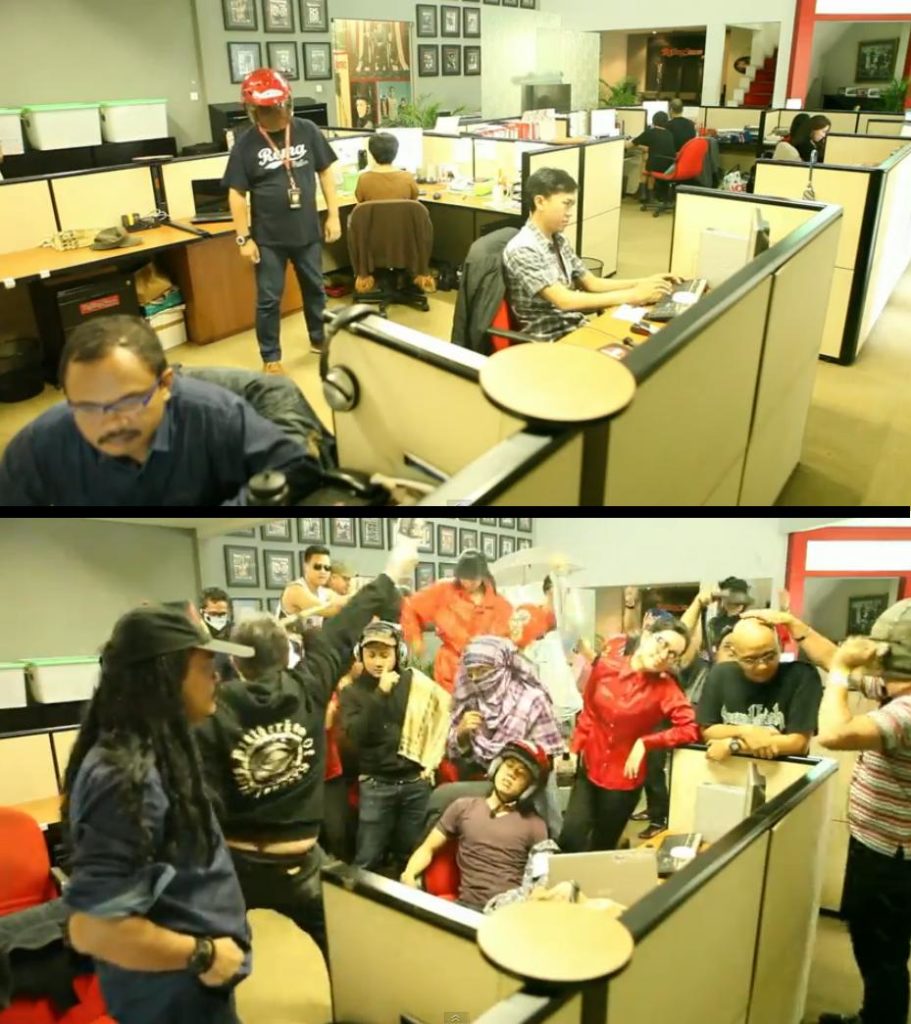By Jessica Pereira
Creation
2012 and 2013 are interesting years for filmed memes involving music and dances. There was the “Gangnam Style”, a hit song by Psy. It inspired people to film themselves while doing the horse dance that the singer performed in his music video. “Call Me Maybe” by Carly Rae Jepsen and “Wrecking Ball” by Miley Cyrus were viral songs too. These birthed many parodies. Then, there was the “Harlem Shake”. It was produced in 2012 and became viral on YouTube in 2013. This roughly 10-year-old internet meme is also a dance style and a music track. Thus, countless videos were created using the song.
This meme’s main requirement is a collective performance. Furthermore, the premise is constant; it begins with an anonymous individual wearing a mask or a helmet and dancing amid an uninterested group of people to the Harlem Shakesong. As soon as the bass of the song drops, said group suddenly joins in and a party ensues with people moving by mimicking convulsions or improvising dance moves. Moreover, the video last about 30 seconds in total and the group of people are often wearing specific clothes, or they are wearing a minimum of clothing. The choreography and concept became popular and went viral when it was reproduced by millions. Thus, the Harlem Shake was born.
Short history
An American DJ and record producer called Harry Bauer Rodrigues, more commonly known as Baauer, released Harlem Shake (the song) commercially in May 2012 through the Mad Decent record label and it was uploaded to YouTube in August. It is categorized as fitting into the genre of bass, hip hop, and trap, which is a style of electronic dance music that originated in the 2010s. Furthermore, the song was well received by music critics and electronic or trap music blogs. However, it only went viral on January 2013 when George Miller, better known as Filthy Frank, Joji, or Pink Guy, who is an Internet personality and YouTuber, uploaded a video showing people wearing spandex suits and dancing to the song. Today, the original video has roughly 65 million views on YouTube. This inspired multiple parodies that were uploaded to the same platform. Many versions amassed an impressive number of views. In turn, internet companies, brands, celebrities, sports teams, politicians, or activists began recreating the Harlem Shake too. A key popular culture moment was when “The Simpsons”, a famous American animated sitcom, created their own version. Furthermore, what is performed in the viral videos is not the original Harlem Shake dance. As the name indicates, it originated from Harlem(New York City) and the residents disliked the use of their dance’s name for the viral song and videos, believing that these mocked this particular part of African American culture. They responded by creating videos demonstrating the original dance, which involves jerky arm and shoulder movements.
Nevertheless, the repeated use of Baauer’s track increased his song’s sales significantly and placed it on the top of the music charts for weeks. However, he did not receive any compensation due to not having cleared the samples of his song. The samples include a voice that says “con los terroristas” in the beginning of the song, which translated means “with the terrorists”. It was taken from a 2006 song called “Maldades” by Hector Delgado, a Puerto Rican rapper. This sentence is followed by a different voice commanding “do the Harlem Shake”, which was sampled from a 2001 song called “Miller Time” by Plastic Little, an American rap group. However, Baauer was compensated through his original post on YouTube by monetizing his video. Regardless, with this track Baauer made history and Billboard, an American music and entertainment magazine, described it as “the biggest viral sensation since PSY’s Gangnam Style”. Thus, only by February 13th of 2013, over 12 000 versions were uploaded on YouTube. However, already by March its virality slowly sank.
How do different groups/people apprehend, use, and spread these viral phenomena?
Most versions of the Harlem Shake follow the format that was described, while adding their own spin on it. One notorious version was uploaded by OnkelSaft, a Norwegian YouTube channel. Thus, in March 2012 naked Norwegian men filmed themselves doing the Harlem Shake near important landmarks in Trondheim, Norway. However, the Norwegian University of Science and Technology disliked that the video of these men dancing in front of the university included their logo and slogan. The creators of the parody reacted by removing these aspects from the video. Regardless, their aim was to promote tourism.
Another interesting use of this viral phenomenon can be traced back to December 2013. This was the incident with “The Daily Caller”, which is a right-wing news website founded by Fox News host Tucker Carlson and the conservative political advisor and lawyer called Neil Patel. Ajit Pai, who served as chairman of the U.S. Federal Communications Commission (FCC), uploaded his own version on the above-mentioned website to mock net neutrality. Net neutrality is a concept describing how all data on the internet should be treated equally by organizations such as Internet service providers. It basically promotes a free and open internet, where content can be accessed without any restriction (content that does not violate laws). In the video, Pai addressed the subject by mentioning what users would still be able to do on the internet, such as posting their food on social media or participating in meme trends, such as the Harlem Shake. Thus, he implied that restricting internet access would not have a considerable impact on the users. The creator of the Harlem Shake song, Baauer, did not appreciate this particular use of his track without his consent. Consequently, he spoke out about the importance of net neutrality and, in 2017 Baauer tweeted “I’m Taking action. Whatever I can do to stop this loser”. His goal was to take down Ajit Pai’s version of the viral phenomenon, as it did not correspond to his own beliefs.
However, while Pai used this viral phenomenon to promote his views on net neutrality, others participated in the trend for an entirely different reason. Thus, the appropriations by multiple companies are quite interesting. Kevin Asthon, technology pioneer, argued in his 2013 article “You didn’t make the Harlem Shake go viral-corporations did” which was published in Quartz, that this phenomenon did not become accidently famous but that its virality is partly due to the companies’ participation in the trend for their own financial interests.
In turn, others used it as a tool to protest. Therefore, another instance was when students were arrested in Cairo for public indecency while creating their own version of the Harlem Shake. Roughly 400 people recreated it to protest President Mohamed Morsi in front of the headquarters of the Muslim Brotherhood. In turn, they also reacted by uploading their own version. However, they requested to have the video removed from YouTube, claiming that it had achieved its goal. A similar situation occurred in Tunisia, where the Education Ministry called for an investigation of the students who participated in the trend in their high school. The students reacted by hacking the ministry’s website and by suggesting a bigger Harlem Shake in front of the ministry’s offices. However, Salafi activists made it their priority to stop the trend, which at times resulted in violence. On social media, this incident even acquired its own name: “The Harlem Shake versus the Halal Shlake”.
Thus, many controversies are linked to the Harlem Shake. In many instances, this viral phenomenon was used for people’s own gain, whether they were political or financial. Either way, it is not solely a song or a dance but a powerful tool to send a message.
Why are these viral phenomena interesting?
The Harlem Shake is an interesting viral phenomenon because unlike other memes, it requires a collective performance by individuals. However, the Harlem Shake was not the only one of its kind. As stated, in 2012 the Gangnam Style, the song and dance by Psy, attracted an equal amount of attention due to its uniqueness. Before that, there was the Shuffle in 2011, which is a dance movement that used the song called Party Rock Anthem by LMFAO, an American electronic dance music duo. As a result, countless people learned the dance. However, long before these examples, there was the Moonwalk first danced by the legendary singer Michael Jackson in 1983. While this does not necessarily require a collective performance, it is still popular today and inspired many to learn said dance. People seem to be drawn to learning dances because it is an easily achievable and fun task. However, in cases such as the Harlem Shake, it becomes a form of expression, a vehicle to share one’s beliefs, whatever they may be. Especially memes have the potential to entertain masses, which thus also encourages companies to participate in these trends. They use viral phenomena as a marketing technique to stay relevant and to maintain a link with their target audience. This technique is still consciously used through the platform called TikTok, that initially also gained popularity through people performing viral dances. It is becoming increasingly common for companies and brands to create a TikTok account solely to participate in a viral trend to increase the level of attention they gain. Interestingly, these specific phenomena come and go within weeks. Examples are the Fortnite Dances or the Pen-Pineapple-Apple-Pen. The former had people performing dances taken from an online video game released in 2017, while the latter is a 2016 viral song and video by Pikataro, a Japanese entertainer. Thus, it is especially the contagious and fleeting virality that makes these phenomena intriguing because they have now become a trivial and constant practice online.
To go further…
Ashton, Kevin, You didn’t make the Harlem Shake go viral – corporations did, in: Quartz, Series: Ideas, URL: https://qz.com/67991/you-didnt-make-the-harlem-shake-go-viral-corporations-did/, (online), 2013.
Soha, Michael & Mcdowell, Zachary J., Monetizing a Meme: YouTube, Content ID, and the Harlem Shake, in: Sage Journals, Vol. 2, Issue 1, URL: https://doi.org/10.1177/2056305115623801, (online), 2016. Steele,
Knight Steele, Catherine, Shaking off the ‘Other’: Appropriation of marginalized cultures and the ‘Harlem Shake’, AoIR Selected Papers of Internet Research, Vol. 3, URL: https://spir.aoir.org/ojs/index.php/spir/article/view/8849, (online), 2013.

HARLEM SHAKE (Rolling Stone Indonesia Edition).webm cc by 3.0
